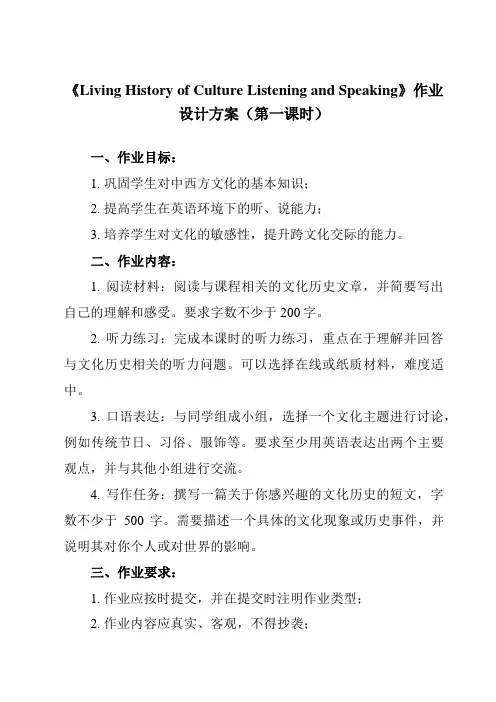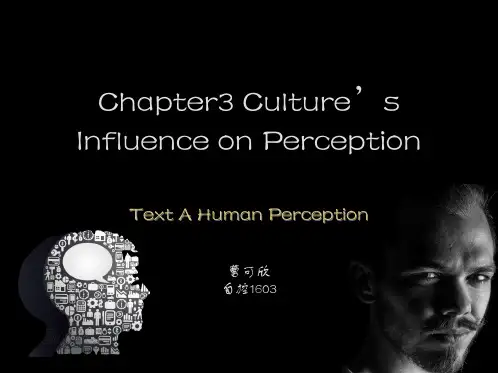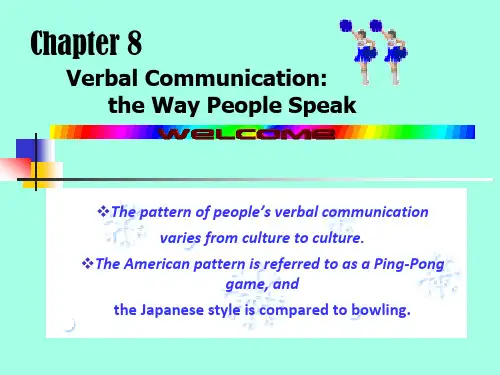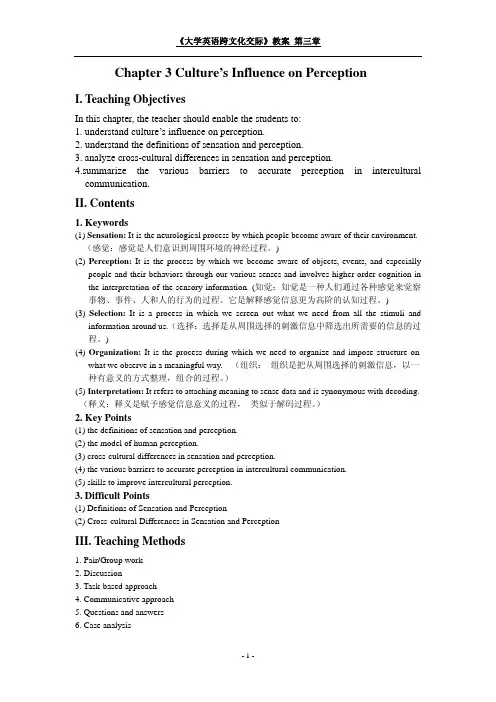跨文化交际教案英文版chapter 6 culture's influence on perception
- 格式:doc
- 大小:2.13 MB
- 文档页数:26


《Living History of Culture Warming up》学历案(第一课时)一、学习主题本课学习主题为“文化传承与生活历史”,通过本课程的学习,学生将了解不同文化背景下的生活历史,增进对多元文化的认识与理解,培养跨文化交际能力。
二、学习目标1. 知识与理解:掌握本课核心词汇和句型,理解文化传承的重要性及其在生活中的体现。
2. 技能与操作:通过课堂互动和小组讨论,能够运用所学知识进行简单的文化交流和表达。
3. 情感态度与价值观:培养尊重多元文化的意识,增强文化自信和国际视野。
三、评价任务1. 课堂表现评价:通过学生在课堂上的积极参与程度、互动交流能力和回答问题情况进行评价。
2. 小组活动评价:以小组为单位进行文化主题讨论,评价小组的合作能力和文化交流表达能力。
3. 作业评价:布置与课程内容相关的作业,如写一篇关于文化传承的短文或进行一次文化主题的演讲准备,通过作业完成情况进行评价。
四、学习过程1. 导入新课:通过展示不同文化的图片和短视频,引导学生谈论对不同文化的感受和认识,激发学习兴趣。
2. 词汇学习:呈现本课核心词汇,通过例句和图片帮助学生理解词义,并进行跟读和拼写练习。
3. 课文听读:播放课文录音,让学生跟读并理解文意。
随后进行分段朗读,检查学生对课文的理解程度。
4. 文化交流讨论:以小组为单位,讨论不同文化背景下的生活习俗、节日庆典等话题,并分享各自的文化经历。
5. 句型练习:通过模拟对话和角色扮演等形式,练习本课重点句型,提高学生的口语表达能力。
6. 文化传承思考:引导学生思考文化传承的意义和方式,以及自己在文化传承中的责任和角色。
7. 总结与作业布置:对本课学习内容进行总结,布置相关作业,如写一篇关于文化传承的短文或进行一次文化主题的演讲准备。
五、检测与作业1. 课堂小测验:进行一次简单的词汇和句型测试,检查学生对本课知识点的掌握情况。
2. 小组演讲准备:学生准备一次关于文化传承的主题演讲,锻炼学生的表达能力和组织能力。

《Living History of Culture Listening and Speaking》作业设计方案(第一课时)一、作业目标:1. 巩固学生对中西方文化的基本知识;2. 提高学生在英语环境下的听、说能力;3. 培养学生对文化的敏感性,提升跨文化交际的能力。
二、作业内容:1. 阅读材料:阅读与课程相关的文化历史文章,并简要写出自己的理解和感受。
要求字数不少于200字。
2. 听力练习:完成本课时的听力练习,重点在于理解并回答与文化历史相关的听力问题。
可以选择在线或纸质材料,难度适中。
3. 口语表达:与同学组成小组,选择一个文化主题进行讨论,例如传统节日、习俗、服饰等。
要求至少用英语表达出两个主要观点,并与其他小组进行交流。
4. 写作任务:撰写一篇关于你感兴趣的文化历史的短文,字数不少于500字。
需要描述一个具体的文化现象或历史事件,并说明其对你个人或对世界的影响。
三、作业要求:1. 作业应按时提交,并在提交时注明作业类型;2. 作业内容应真实、客观,不得抄袭;3. 小组讨论应充分讨论,各组员需积极发言,共同完成作业;4. 写作任务应尽可能用英语完成,如遇到无法用英语表达的内容,可适当使用中文进行说明。
四、作业评价:1. 教师将对提交的作业进行批改,给出相应的分数或评价;2. 作业分数将纳入学期总评成绩,以5%为宜;3. 对于优秀作业,教师将进行公开表扬或推荐发表。
五、作业反馈:1. 学生应根据教师的批改和评价,对作业进行认真反思,找出自己的不足之处并加以改进;2. 教师将定期向学生提供反馈,包括作业完成情况、存在的问题和建议等;3. 学生应积极回应教师的反馈,提出自己的看法和改进措施。
作业设计方案(第二课时)一、作业目标:1. 复习并深化对历史文化主题的理解;2. 提高听力理解能力,包括捕捉关键信息、推断隐含意义;3. 提高学生口语表达能力,包括口头描述、表达观点。
二、作业内容:1. 听力练习:学生需完成一份历史文化主题的录音材料,内容涵盖不同时期的文化发展、重要人物、事件等。

跨文化商务沟通英文版第六版教学设计教学目标本课程旨在帮助学生了解跨文化商务沟通领域,掌握跨文化交流的基本概念,了解文化差异带来的影响,并学会应对跨文化沟通中的挑战。
教学大纲1.跨文化商务沟通基础概念–定义和基本概念–国际商务交流的三大挑战–跨文化商务沟通中的重要角色2.跨文化沟通中的文化差异–文化定义和分类–文化差异的定义和解释–跨文化交际中的文化障碍和判断力3.跨文化商务沟通的策略–意识到跨越国际界线所带来的沟通障碍–多样性的概念和重要性–建立跨文化关系和沟通桥梁的策略4.具体案例研究–美国文化对中国商人的影响–中国文化和审批过程对外国公司的影响–跨国公司中的文化冲突案例课程教材1.卡罗琳·伍德的《跨文化商务沟通》第六版(英文版)。
2.大量相关的文化差异案例研究材料。
教学方法1.授课、讲解和案例分析。
2.互动式学习和小组讨论。
3.学生的个人分组和尝试实践。
作业和考核1.每周阅读指定内容和材料。
2.独立完成个人或小组项目。
3.学期中期和末期的作业、笔试和小组项目展示。
课程效果本课程的学生将会了解到跨文化商务沟通的基本概念和相关挑战,了解文化差异的定义和解释,掌握应对跨文化沟通中的挑战的策略,并通过案例研究实践跨文化商务沟通技巧。
参考资料1.Carol Kinsey Goman. The Nonverbal Advantage: Secrets andScience of Body Language at Work. Berrett-Koehler Publishers,Inc. 2011.2.Peter F. Drucker. Management Challenges for the 21st Century.HarperBusiness. 1999.3.Edward T. Hall. Beyond Culture. Anchor Books. 1977.。

课程目标:1. 培养学生对跨文化交际重要性的认识,提高跨文化交际意识。
2. 通过案例分析、小组讨论和角色扮演等活动,使学生掌握跨文化交际的基本技巧。
3. 拓宽学生的国际视野,增强跨文化交际能力。
教学对象:大学英语专业学生教学课时:2课时教学内容:1. 跨文化交际的概念及重要性2. 跨文化交际的障碍与应对策略3. 中西方文化差异分析4. 跨文化交际案例分析教学过程:第一课时一、导入1. 教师简要介绍跨文化交际的概念,引导学生思考跨文化交际在现代社会的重要性。
2. 学生分享自己在跨文化交际中的亲身经历,引发对跨文化交际问题的讨论。
二、讲授1. 跨文化交际的概念及重要性- 解释跨文化交际的定义,强调其在全球化背景下的重要性。
- 列举跨文化交际在日常生活、工作、学习等领域的应用实例。
2. 跨文化交际的障碍与应对策略- 分析跨文化交际中可能遇到的障碍,如语言、价值观、信仰等。
- 介绍应对策略,如尊重差异、了解文化背景、提高跨文化意识等。
三、案例分析1. 教师展示中西方文化差异的案例,如饮食、节日、礼仪等。
2. 学生分组讨论,分析案例中的文化差异及其影响。
3. 每组派代表分享讨论成果,教师点评并总结。
四、角色扮演1. 教师提供情景,学生分组进行角色扮演,模拟跨文化交际的场景。
2. 角色扮演结束后,各小组分享体验,教师点评并总结。
第二课时一、复习1. 教师回顾上一节课的内容,检查学生对跨文化交际概念、障碍与应对策略的掌握程度。
2. 学生提问,教师解答。
二、讲授1. 中西方文化差异分析- 深入分析中西方文化在价值观、思维方式、交际方式等方面的差异。
- 结合具体案例,引导学生思考文化差异对跨文化交际的影响。
2. 跨文化交际技巧- 教授学生在跨文化交际中应遵循的原则,如尊重、耐心、倾听等。
- 通过案例分析,使学生了解如何运用跨文化交际技巧解决实际问题。
三、总结1. 教师总结本节课的主要内容,强调跨文化交际的重要性。






Chapter 3 Culture’s Influence on PerceptionI. Teaching ObjectivesIn this chapter, the teacher should enable the students to:1. understand culture’s influence on perception.2. understand the definitions of sensation and perception.3. analyze cross-cultural differences in sensation and perception.4.summarize the various barriers to accurate perception in intercultural communication.II. Contents1. Keywords(1) Sensation: It is the neurological process by which people become aware of their environment.(感觉:感觉是人们意识到周围环境的神经过程。
)(2) Perception: It is the process by which we become aware of objects, events, and especiallypeople and their behaviors through our various senses and involves higher-order cognition in the interpretation of the sensory information. (知觉:知觉是一种人们通过各种感觉来觉察事物、事件、人和人的行为的过程。
它是解释感觉信息更为高阶的认知过程。
高中英语跨文化交际教案一、教学目标1. 了解跨文化交际的概念和重要性。
2. 掌握跨文化交际中的基本礼貌和常见礼仪。
3. 培养学生的跨文化意识和跨文化沟通能力。
二、教学内容1. 跨文化交际概述- 定义:跨文化交际是指在不同文化背景下进行有效沟通和交流的能力。
- 重要性:在全球化背景下,跨文化交际能够促进不同国家和民族之间的相互了解和合作。
2. 礼貌与礼仪a) 礼貌与礼节的定义- 礼貌:尊重他人、关心他人的行为表达和态度。
- 礼节:在交往中遵循的一系列行为准则和规范。
b) 跨文化交际中的礼貌与礼仪- 问候和介绍:不同国家有不同的问候方式和介绍习惯,应注意避免冒犯他人。
- 礼仪:对不同国家的饮食礼仪、礼品送礼方式等了解,避免造成文化冲突。
3. 跨文化意识与沟通策略a) 跨文化意识的培养- 尊重差异:不同国家、民族有不同的价值观念和行为习惯,应理解、尊重并接受这些差异。
- 文化敏感性:通过了解不同国家的历史、文化和社会背景,提高对跨文化交际的敏感性。
b) 跨文化沟通策略- 避免刻板印象:不应对某个国家的人民或文化有片面的、歧视性的评判。
- 学习有效沟通技巧:如适当运用肢体语言、避免使用难懂的俚语和口语,以确保信息传达的准确性。
三、教学过程1. 导入与引入- 通过举例子、图片或视频等方式,引出跨文化交际的概念和重要性。
2. 学习礼貌与礼仪- 分组讨论并总结不同国家的问候方式和介绍礼仪。
- 组织角色扮演活动,让学生在模拟情境中学习礼仪。
3. 培养跨文化意识- 提供跨文化案例,让学生讨论其中的文化差异与挑战。
4. 学习跨文化沟通策略- 分组学习并展示有效的跨文化沟通技巧和策略。
5. 拓展练习- 学生分角色进行跨文化交际对话,并通过讨论与点评互相提高。
四、教学评价1. 学生小组展示的内容和讨论的深度。
2. 角色扮演活动中学生的表现与沟通效果。
3. 跨文化交际对话的流畅度和准确性。
五、教学延伸1. 提供更多的跨文化案例和学习资源。
跨文化交际(含教案)(高中英语选修课)跨文化交际一、课程基本信息1、课程中、英文名称:跨化交文际、Cross-cultural Communication2、课程类别:专业专选课程3、课程学时:18学时4、学分:2分二、课程的目的与任务:跨文化交际作为一门学科涉及到文化和交际的各个层面,包括语言交际、非语言交际、人们之间的相互交往,以及不同文化之间的观念和信仰等。
该课程的目的在于通过不同文化差异的比较研究,分析跨文化交际案例,提高学生对文化差异的敏感性,提高不同文化语境中语言交际的能力,从而更好地适应不同文化环境。
使学生了解其他文化的社会文化习俗和价值观念;在语言学习的同时,更多关注相关国家的文化,特别是通过与本族文化的对比,提高跨文化交际能力,以适应社会发展和国际交流的需要,增加跨文化交际意识,并最终形成跨文化交际能力。
三、课程的重点和基本要求:(一)课程的重点本课程教学的重点是增强学生对跨文化交际中文化差异的敏感性,帮助学员解决在跨文化交际中因文化的差异而产生的种种问题。
通过典型实力分析,模拟交流联系,交际失误分析,英汉双向练习等多种形式,使学生认识语言,文化和交际三者之间的关系,加深对对象国文化的了解,掌握在处理跨文化交际中一些微妙问题时所需要的基本知识和技巧,提高跨文化交流的质量。
(二).基本要求:1、了解跨文化交际研究的范围和目前发展的动向。
2、掌握跨文化交际研究的基本方法,并运用来解决一些实际问题。
3、奠定向该学科研究纵深发展的理论基础。
四、教学内容及要求本课程以语言学习为前提,强调在语言学习的过程中提高利用外语进行跨文化交际的能力,通过对交际与语言,语言与文化,文化与价值观的学习和讨论,提高跨文化交际意识;通过对文化现象的思考和讨论,反思语言学习过程,增加对文化差异的敏感性;通过课堂活动和案例学习,提高跨文化交际意识和能力,达到有效交流的目的。
1.通过学习,学生能够了解语言及非语言交际在跨文化交际中的重要作用及应用规则。
Chapter VI Culture’s Influence on PerceptionⅠTeaching Objectives1. To identify Hofstede’s cultural dimensions and cultivate students to be able to understand thevarious implications of cultural values for international communication2. To identify how culture affects sensing3. To identify the process of human perception4.To identify the distinction between high and low context culturesⅡLeading inⅢT eaching ProceduresStep1Have students look at the following lead-in pictures:Ask students warming-up questions:What can you see in these pictures?What kind of ability do you employ to identify these pictures?Step26.1SensingGeneral IntroductionSensation is the neurological process by which people become aware of their environment. Of human senses, sight, hearing, smell, taste, and touch are the most studied.The Human Information Receptor People’s Senses and Their LimitationsTactile StimuliOlfactic Stimuli(Smell of exhaustfumes)Auditory Stimuli’s police whistle)Tactile Stimuli(other pedestrian bumps into you)to you)Auditory Stimuli(car horns)Visual Stimuli(color ofstoplight)Visual Stimuli(officer directingTaste StimuliTaste Stimuli(flavor of bitter)e. TouchTouch may simply be considered as one of five human senses; however, when a person touches something or somebody, this gives rise to various feelings. Thus the term "touch" is actually the combined term for several senses.Effects of Culture on SensingDuring intercultural communication, many of the stimuli come from the cultural, microcultural, andenvironmental context.No two of us can assume that our sensations are the same. The routefrom stimulus to sensation is in part conditioned by culture.Stinky tofu (Strong-smelling preserved bean curd) is disfavored by quite a large number of people,however, it is favored greatly by people in the south, esp. in Hunan Province.6.2 PerceivingThe Process of PerceptionThe process of perception can be divided into three stages: selection, organization, and interpretation. a. SelectionThe first step is selection. Within their physiological limitations, people are exposed to more stimuli than they could possibly manage.b. OrganizationThe second step is organization. Along with selecting stimuli from the environment, peoplemust organize it in some meaningful way.What are they doing?Culture can affect the process of perception when communication takes place. When communicators come from different cultures, however, not only the meanings, but also the mental categories are very different.Cross-cultural Difference in Sensation and PerceptionThere are four reasons for which people differ across cultures in their ability to gather incoming information:a. Conditions of the physical environmentb. Indirect environmental conditionsc. Genetic differencesd. Cultural differences in how people interact with their environment 6.3 High versus Low ContextHave students listen tothe lead-in case High-context Culture and Low-context culture .Ask students warming-up questions:● Why did the Chinese doctor feel unhappy and distressed?● What are the differences in ways of expression between the Chinese doctor and the Canadiandoctor?● Are the differences in their ways of expression and their communicative conflicts caused, tosome extent, by the different cultures in which they were brought up? ⏹ High-Context CultureCultures in which little of the meaning is determined by the context because the message is encoded in the explicit code are labeled low-context culture.An American standing on chair in restaurantgiving speech at his leaving his hometown⏹Low-Context CultureCultures in which less has to be said or written because more of the meaning is in the physical environment or already shared by people are labeled high-context culture.Tea Ceremony⏹Comparisons Between High-Context Culture and Low-Context CultureIn low-context cultures, verbal messages are elaborate and highly specific. Logic and reasoning are expressed in verbal messages; in high-cultures, most of the information is either in the physical context or internalized in the person.Case Analysis: Chinese Style—Nonverbals●What are the differences in communication styles between the Chinese old scholar and thewestern traveler?●Can you imagine some problems or communicative barriers caused by differentcommunication styles of high-context and low-context culture.Do you think they will have communication problemsdue to their different communication styles.Step3Distinguishing between High-context Culture and Low-context Culture:辨别高语境文化和低语境文化:教师通过辨别不同的文化现象引导学生了解高语境文化和低语境文化。